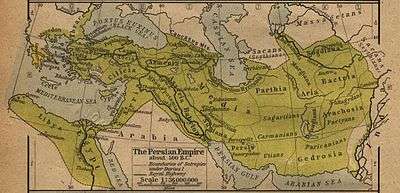Carmania (satrapy)
_-_Asiae-Tabula_IX.jpg)
Carmania (Greek: Καρμανία, Karmanía) was a province ("satrapy") of the Achaemenid and Sassanid Persian empires. The region is approximately equal to that of modern-day Kermān Province in Iran. Little is known about the exact boundaries of ancient Carmania, which may have fluctuated. It is not mentioned as a separate province in translated royal Achaemenid inscriptions (it may have been part of Persis at one time) although it is mentioned by Arrian.
At the time of Alexander's invasion it was a satrapy on the Persian Gulf coast west of Hormoz. It was bounded on the east by Gedrosia. Some authors, such as Ptolemy, distinguished the fertile southern areas of Carmania, known for its teak wood, from the northern wastes of "Desert Carmania" (Latin: Carminia Deserta), which stretched as far as Parthia and Aria.
Alexander erected a pillar on the Carmanian coast, possibly marking the edge of his empire, and established the city Alexandria Carmania at a currently unknown site, probably in the area of Gavkosh or Gulashkird. Marco Polo later visited this town.
By the end of the rule Antiochus IV in 163BC, the Seleucid empire had lost control of their eastern Persia area, including Persis and Seistan.
We must assume that Carmania, had become an independent kingdom called Ormuz,[1][2] the capital of which was Arkiotisas in the upper Jiroft basin. Numismatic evidence indicates an otherwise unknown dynasty of kings, Bellaios, Tigraios and Goaisos. Arkiotisas was briefly an important post on the trade route from India to Persepolis and thence Rome, and was clearly identified in the Peutinger Table as a half-way house between Seistan and Ormuz, there may have been visited by Marco Polo. The kingdom was after two centuries was absorbed into the Bactrian or Parthian kingdoms.
References
- ↑ Pliny XI 110.
- ↑ Not to be confused with the latter Kingdom of Ormus.
Coordinates: 30°17′27″N 57°04′04″E / 30.2907°N 57.0679°E

